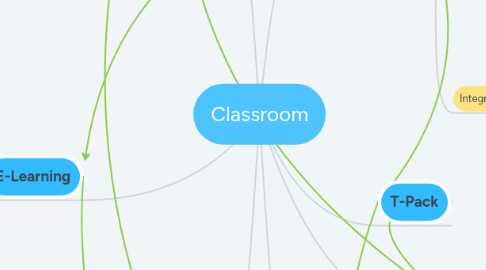
1. Teaching
1.1. Teacher as Facilitator
1.1.1. Direct/Guide/Independent
1.2. Student-Centered
1.2.1. PBL/CBL
1.2.1.1. Life Skills/Soft Skills
1.2.1.1.1. Workforce/21st Century Skills
1.2.2. Deeper Learning/collaboration
1.3. STEAM
1.3.1. Integrate Subjects
1.4. Rubric
1.4.1. Organization/Content/Craftsmanship/Mechanics
2. E-Learning
2.1. Types
2.1.1. Blended
2.1.1.1. Face to Face/online
2.1.2. Online
2.2. Standards
2.2.1. iNACOL
2.2.2. CSUChico
2.3. Flexibility
2.4. Lessons Online/Blended
2.4.1. Synchronous
2.4.1.1. Learning/Activities Students Time
2.4.2. Assessment
2.4.3. Aspects of Design
2.4.3.1. Font/Color/Bold/Repetition/Flow/Graphics
2.4.4. Asynchronous
2.4.4.1. Real-Time Learning
2.4.4.1.1. Discussion Boards
2.4.4.1.2. Webinars
2.4.5. Evaluation
2.4.5.1. Student/Teacher
2.5. Deeper-Learning
2.5.1. Post/Read/Reread/Evaluate/Question/Collaborate/Create/React
2.5.2. Higher Order Thinking Skills
2.6. Host
2.6.1. Moodle/Haiku/Google/Canvas/Emodo
3. Assessment
3.1. Formative
3.1.1. On the Spot/Dail\y
3.1.1.1. Blog
3.1.1.2. Concept Map
3.1.2. Assess Undersanding
3.1.3. Modify
3.2. Summative
3.2.1. End of Year/Lesson
3.2.2. Aligned to Content Standards
3.2.3. Portfolio Review
4. Technology
4.1. Web 2.0 Tools
4.1.1. Collaboration/creation
4.1.1.1. Google Tools
4.1.2. Pintrest
4.1.3. Infographic
4.2. Coding
4.2.1. Scratch.com
4.2.2. 21ST Century Skill
4.3. Digital Citizenship
4.4. Reports
4.4.1. Horizon
4.4.1.1. School Culture/Deeper learning
4.4.1.2. STEAM/Coding as Literacy
4.4.1.3. Redesign Classrooms
4.4.1.3.1. Learning Spaces
4.4.1.3.2. Flexible Seating
4.4.1.3.3. Mobile Stations
4.4.1.3.4. Maker Space
4.5. Integration
4.5.1. Computers/Mobile Devices/Cameras
4.5.2. Social Media/Networks/Software/Internet
4.5.2.1. IOT
5. Lessons Design
5.1. Learning Theory
5.1.1. Cognativism
5.1.1.1. Short/Long Term Memory
5.1.2. Behaviorism
5.1.2.1. Stimulus/Response
5.1.3. Constructivism
5.1.3.1. Learner/Environment
5.2. UDL
5.2.1. Engagement
5.2.2. Representation
5.2.3. Action/Expression
5.2.3.1. Differentiate Instruction
5.3. Instructional Design
5.3.1. Addie
5.3.2. Dick/Carrey
5.3.3. Assure
5.3.4. Gagne's 9 Events of Instruction
6. student
6.1. 12 Brain Rules
6.1.1. Exercise/Survival/Wiring/Attention Etc..
6.2. Neurocognition
6.2.1. Memory/Speed/Attention/Focus/flexibility/Creativity
6.3. Neuroplasticity
6.3.1. Synapses
